The “Oceanic class” Liners
The White Star Line commissioned the constuction of 6 sister ships.
Other ships produced after the "Oceanic" class with similar specifications:
SS Oceanic (1870)
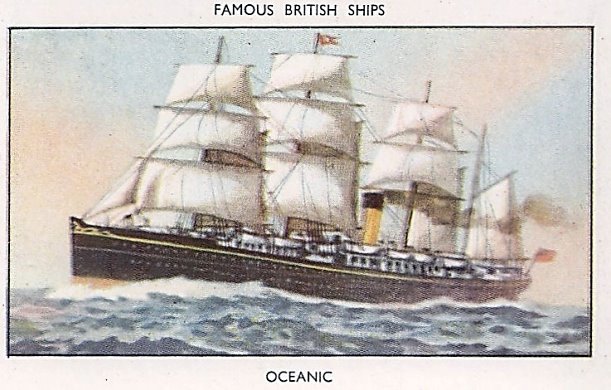
The Oceanic was the first of a series of six sister ships constructed in rapid succession.
She was built by Harland and Wolff under keel number 73. She was launched on 27 August 1870, arriving in Liverpool for her maiden voyage on 26 February 1871.
She was 420.4 feet long with a beam of 40.1 feet and a gross tonnage of 3707. She was powered by a combination of steam and sail. Twelve boilers generated steam to power a single four cylinder compound steam engine. A single funnel exhausted smoke and four masts carried sail.
Her iron hull was divided into eleven watertight compartments. Passenger accommodations were located on the two decks concealed within the hull. The Oceanic could carry 166 First Class passengers (also called Saloon passengers). Their cabins were placed amidships so to reduce the amount of noise and vibration passengers could hear from the engines. 1000 Steerage passengers were housed at the bow and at the stern of the ship. She was headed with a crew of 143.
The WSL had spared no expense in her construction, and she was described in newspapers as an “imperial yacht.”
There were plenty of innovative fixtures and fittings on board. For example, the portholes were larger than those found on contemporary ships; running water was available in First Class cabins and there were electric bells to summon the stewards.
A First Class passage cost £18.18s 0d, and a return ticket would cost 27 guineas. Steerage rate was as low as other First Class passengers on other lines.
On 2 March 1871, carrying only 64 passengers, the Oceanic set sail from Liverpool to New York on her maiden voyage captained by Sir Digby Murray. Soon after leaving the harbour, the engines began to overheat and she had to return to port and her voyage abandoned. The maiden voyage finally took place on 16 March 1871.
In January, 1872, the Oceanic underwent a refit, during which a larger forecastle was added to help prevent the bow being inundated during high seas. Two new boilers were added to increase steam pressure and thus engine power, and the four masts were shortened. On 11 March 1875, she was chartered to the Occidental & Oriental Steamship Company for service between San Francisco, Yokohama and Hong Kong. The WSL provided the officers whilst the crew were Chinese. The ship itself remained in the WSL colours, but flew the O&O flag. For many years she serviced this route.
On 22 August 1888, The Oceanic collided with the City of Chester just outside the Golden Gate, San Francisco.
In 1895, The Oceanic was returned to the WSL. It was planned to return her to service and so she was sent back to Harland and Wolff for her engines to be conditioned. Unfortunately, it was too uneconomical to perform so she was sold for scrap. She left Belfast for the last time on 10 February 1896.
On 2 March 1871, carrying only 64 passengers, the Oceanic1 set sail from Liverpool to New York on her maiden voyage captained by Sir Digby Murray. Soon after leaving the harbour, the engines began to overheat and she had to return to port and her voyage abandoned. The maiden voyage finally took place on 16 March 1871.
In January, 1872, the Oceanic underwent a refit, during which a larger forecastle was added to help prevent the bow being inundated during high seas. Two new boilers were added to increase steam pressure and thus engine power, and the four masts were shortened.
On 11 March 1875, she was chartered to the Occidental & Oriental Steamship Company for service between San Francisco, Yokohama and Hong Kong. The WSL provided the officers whilst the crew were Chinese. The ship itself remained in the WSL colours, but flew the O&O flag. For many years she serviced this route.
On 22 August 1888, The Oceanic collided with the City of Chester just outside the Golden Gate, San Francisco.
In 1895, The Oceanic was returned to the WSL. It was planned to return her to service and so she was sent back to Harland and Wolff for her engines to be conditioned. Unfortunately, it was too uneconomical to perform so she was sold for scrap. She left Belfast for the last time on 10 February 1896.
SS Atlantic (1870)
The second liner to be commissioned by the WSL was the Atlantic. She was built by Harland and Wolff under keel number 74, launched on 1 December 1870 and completed 3 June 1871. She had a gross tonnage of 3,707.

The Atlantic was the same size as her sister the Oceanic. On 8 June 1871, she set out on her maiden voyage from Liverpool to New York, via Queenstown in Ireland. The passengers enjoyed the crossing and the voyage was proved a great success.
On 20 March 1873, the Atlantic departed from Liverpool on her 19th voyage and final voyage. She transported 952 people (835 passengers and 117 crew). During the voyage, the captain decided to make port at Halifax, Nova Scotia, to replenish coal.
Disaster struck on the evening of 31 March 1873. A storm made visibility difficult and the seas rough. Neither Captain James A Williams nor Third Officer Brady know that the Atlantic was 12½ miles off course west of Halifax Harbour. At 3.15 a.m. on 1 April 1873, the Atlantic struck a rock off Marr's Head, Meagher's Island (now Mars Head, Mars Island), Nova Scotia.
The ship was carrying 10 lifeboats which were all released and lowered by the crew. Unfortunately, they were all washed away or smashed as the ship quickly filled with water and capsized. Local residents from the village of Lower Prospect tried to coordinate a rescue but at least 535 people died – only 371 survived. From the passengers of 952, 156 were women and 189 were children - only a 12-year-old boy survived.
This was the worst recorded civilian loss of life in the North Atlantic until the wreck of La Bourgogne on 2 July 1898.
An inquiry into the sinking found that officers of the ship had failed to take soundings, post a masthead lookout, reduce speed, or wake the captain as they approached the unfamiliar coast. They somehow did not spot the large Sambro Lighthouse.
The Canadian government inquiry reported that “the conduct of Captain Williams in the management of his ship during the twelve or fourteen hours preceding the disaster, was so gravely at variance with what ought to have been the conduct of a man placed in his responsible position.”
The wreck lies some 12 to 18 metres underwater and is heavily broken up. A few artefacts recovered during several salvage operations over the years are on display at the Maritime Museum of the Atlantic in Halifax, Nova Scotia and also at the SS Atlantic Heritage Park and Interpretation Center, in Terence Bay, Nova Scotia.
There is a monument to the wreck located at the mass grave near the interpretation centre in the Terence Bay Anglican Cemetery A smaller monument marks a second mass grave at the Catholic cemetery.
SS Baltic (1871)
In 1871, the third ship to be commissioned by the WSL was originally going to be named Pacific but she was instead named Baltic because a ship from the Collins Line with the same name had disappeared in 1856.
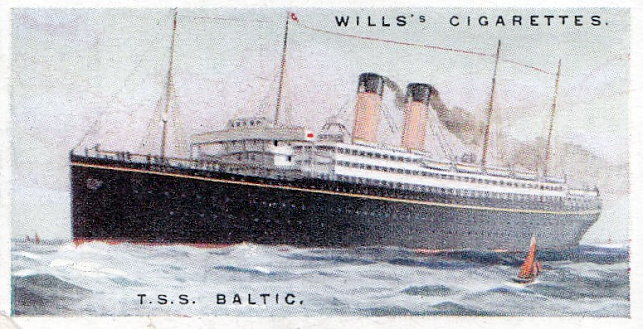
The Baltic was built by Harland and Wolff under keel number 75, launched on 8 March 1871 and completed on 2 September 1871. She was 420.4 feet long with a beam of 40.9 feet and had a gross tonnage of 3,707.
SS Republic (1871)
The fourth ship was called the Republic. She was captained by Sir Digby Murray, who had taken all of the “Oceanic class” of ships on their maiden voyages. It was intended that she would be the last of four ships of the class. On 1 February 1872, the Republic made her maiden voyage from Liverpool to New York City.
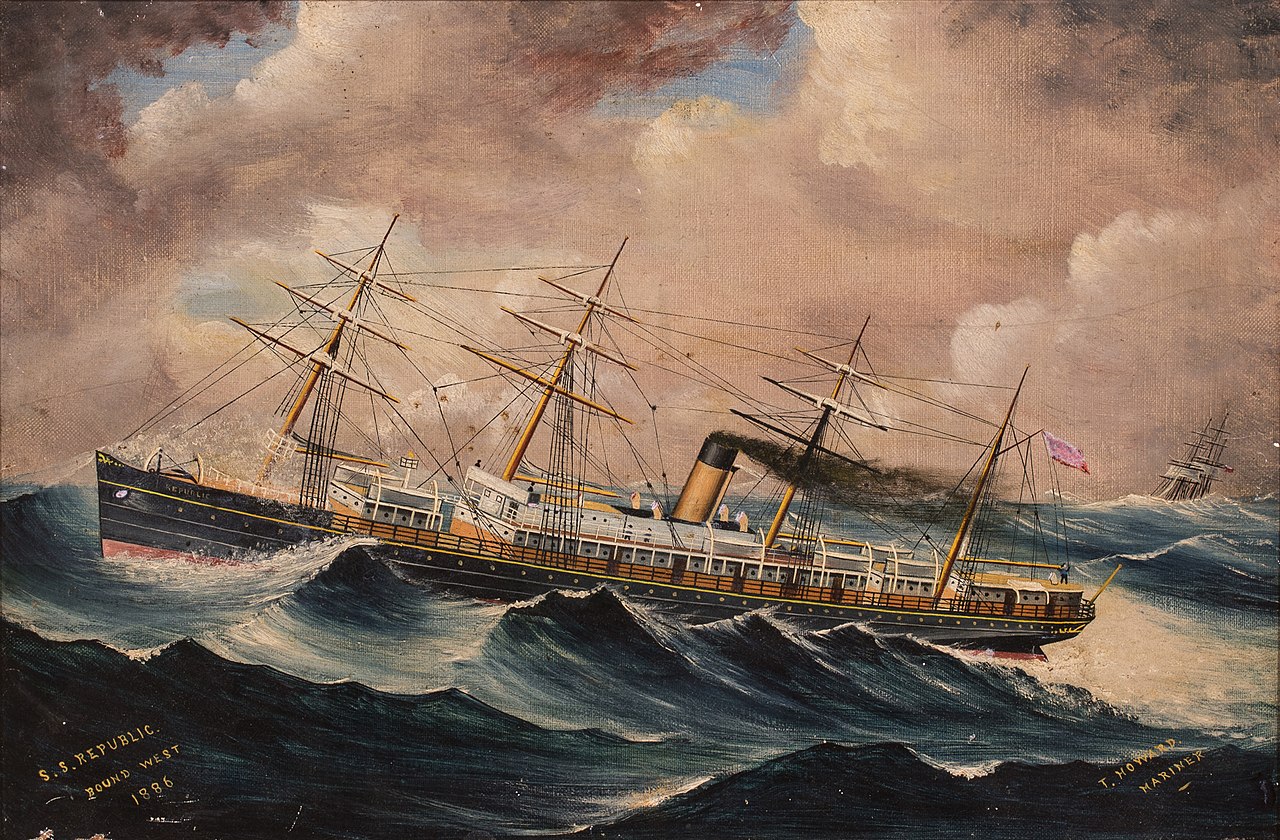
Thomas Ismay wanted to compete with the Pacific Steam Navigation Company so after a successful voyage, the ship was chosen to serve on the South Atlantic and Pacific route. It was the WSL's first voyage on this route. When faced with this competition, the Pacific Steam Navigation Company struck back and commissioned the Tacora. The two ships would compete to see which one could arrive at Chile first. The Republic succeeded but subsequent Pacific crossings were cancelled due to high costs and the Republic was placed back on the Atlantic run to New York.
In 1874, the Republic was “put on reserve,” when the WSL commissioned the Britannic and the Germanic, to be used when other ships were out of service needing repair.
In 1888, the Republic underwent a redesign, and Second Class passenger facilities added.
In January 1889, the ship under the command of Captain Edward Smith set sail on her final voyage under the ownership of the WSL.
She was sold to the Holland American Line for £35000. She was again sold several times before been sold for scrap in 1909. She had been in service for 39 years, the longest service of any of the “Oceanic class” liners.
SS Adriatic
Due to the success of the first four “Oceanic class” liners, the WSL decided to commission two more ships; the Adriatic and the Celtic. Both ships were built by Harland and Wolff.
The Adriatic was built under keel number 77, launched on 17 October 1871 and completed on 31 March 1872. She began her maiden voyage on 11 April 1872.
She was 437.2 feet long with a beam of 40.9 feet and had a gross tonnage of 3,888. She sailed from Liverpool to New York under the command of Sir Digby Murray.
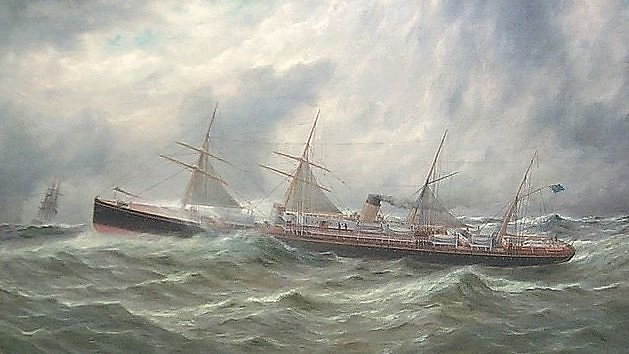
The Adriatic was very similar to the other “Oceanic class” liners with four masts with one funnel. She was designated as the Line’s “flagship.” She had the capacity to carry 1150 passengers. Most of whom would be Steerage Class.
The WSL wanted to be seen as forward thinking by making the passage for steerage passengers more comfortable. Under Ismay’s direction, steerage quarters were moved forward and higher up, away from noisy machinery. Married couples were provided with private accommodation instead of sharing dormitories. Third Class passengers were also provided with beds, bedding and eating utensils. Such improvements proved very popular and the WSL saw increased passenger numbers.
In June 1872, the Adriatic set a new eastbound Atlantic record with an average speed of 14.52 knots to win the Blue Riband.
Unfortunately on 13 December 1872, the Adriatic ran into a severe storm which caused her to lose two of her four blades from her propeller. Whilst trying to reach New York, the Adriatic came across the severely damaged Allan which was sinking. The Allan was a full-rigged ship (about 900 tons) owned by Rankin & Gilmore of Glasgow. The Adriatic picked up 20 crew members and took them to safety.
The Adriatic was very successful during her 27 year career but when the Oceanic (Oceanic No. 2) entered service in 1899 she was sold for scrap.
SS Celtic and collision with SS Britannic
The Celtic was built by Harland and Wolff under keel number 79, launched on 18 June 1872 and was completed on 17 October 1872. She was almost a duplicate of the Adriatic and was the last of six “Oceanic class” liners. She was originally going to be christened "Arctic" but a ship with the same name owned by the Collins Line sank in 1854 so Celtic was chosen instead. Two years later, the Collins Line would lose their Baltic. Losing these two ships hastened the demise of the Line.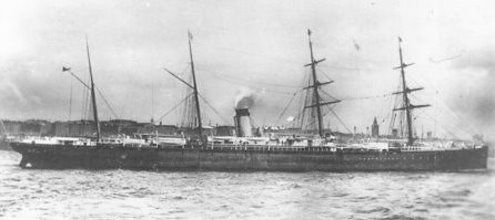
The Celtic made her maiden voyage on 24 October 1872. In 1880, Edward John Smith joined the crew of Celtic as her Fourth Officer.
On 11 May 1887, the Celtic departed Liverpool bound for New York with 104 First Class and 765 Steerage passengers on board. She was under the command of Captain Peter J. Irvine. A week later (18 May), the Britannic (reviewed below) left New York bound for Liverpool under the command of Captain Hamilton Perry with 176 First Class and 300 Steerage passengers. Both vessels sailed into thick fog.
Captain Perry was steaming at a speed of 14.5 knots (full ahead). He considered the speed to be appropriate considering the weather and sea conditions. Captain Irvine had been sailing at a slower speed of 13.5 knots. At about 5:25 p.m. on 19 May, Irvine heard a ship’s whistle but ignored it. He then heard another one a few minutes later and ordered a change in course. Both vessels reduced speed. The bow of the Celtic struck the portside of the Britannic almost at right angles. The accident occurred about 350 miles east of Sandy Hook, New Jersey.
The Celtic suffered no loss of life. The Britannic sustained more damage than the Celtic. At least four steerage passengers were killed outright on board the Britannic and at least six were severely injured. She suffered a four feet gash below the waterline. The passengers on board the Britannic began to panic thinking that she would founder and rushed the lifeboats.
Her captain managed to restore some order and the lifeboats were filled with women and children.
After the lifeboats were launched, it was evident that the Britannic would stay afloat so some of the lifeboats were returned to pick up survivors still board. The lifeboats made their way to the Celtic. The two boats remained together and were joined by the Wilson Line’s Marengo and the British Queen of the Inman Line. In the morning they all made their way to New York.
The Celtic was sold in 1893 to the Thingvalla Line and renamed the Amerika.
In 1898, she was scrapped.
SS Britannic 1874
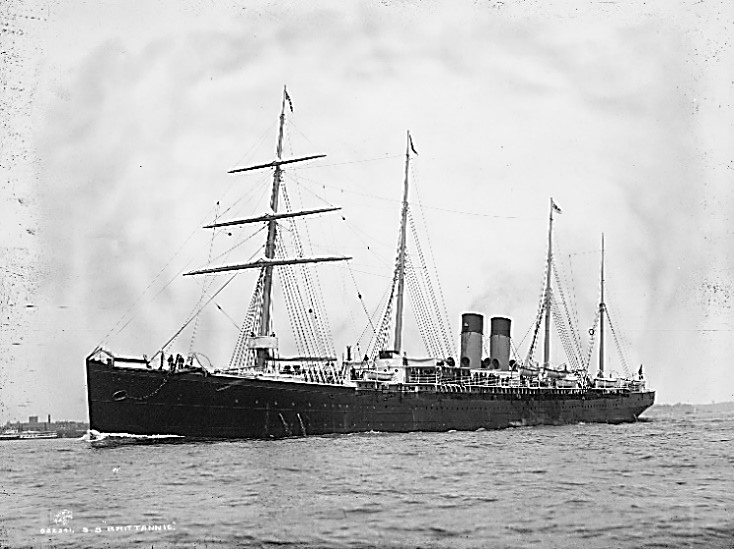
The Britannic was designed by Sir Edward Harland and built by Harland and Wolff under keel number 83. She was 455 feet long with a beam of 45.2 feet and had a gross tonnage of 5004. She was launched on 3 February 1874 and completed on 6 June 1874. Her maiden voyage was on 25 June 1874.
She could carry up to 1720 passengers which included 220 Saloon Class passengers and 1500 Steerage passengers. Her accommodation and services were similar to those on the “Oceanic class” liners.
She set a new speed record for westbound Atlantic crossing and won the Blue Riband during a voyage on 27 October – 4 November 1876. The crossing took seven days, thirteen hours and eleven minutes. She averaged 15.43 knots. She lost the record to her sister the Germanic the following year.
On 25 June 1881, the Britannic departed New York bound for Queenstown and then Liverpool. After leaving Queenstown, the Britannic ran into heavy fog.
On the morning of 4 July 1881, Captain Perry heard the Hoots Fog Signal and Mr Kitt thought the signal was from the Tuskar Light. Both of these are guns fired at regular intervals to help the ship’s navigators.
Captain Perry altered course towards what he thought was Holyhead. He was in fact off the coast of Kilmore, Co Wexford, Ireland.
The ship ran aground. The Britannic sprung a leak in her engine room which had to be patched up before returning to Liverpool.
1500 tons of cargo were taken to Waterford. With sufficient cargo removed and the water pumped out, she lifted off the bottom and refloated again. However, at Liverpool the ship sprung another leak and began to sink. She was towed to South Bay beach. Within a few days, she was afloat again and returned to Liverpool to be dried out.
The Britannic was requisitioned by the Royal Navy in 1899 and was converted into a troopship transporting soldiers to the Second Boer War. She was sold for scrap in 1903 for £11,500.
SS Germanic 1874
Over the years, the WSL purchased several ships including the Gaelic (1873), the Belgic (1874) and the Germanic. The Germanic cost a staggering £200,000, but became the WSL’s longest lived liner. She replaced the Oceanic and spent 75 years on the seas.
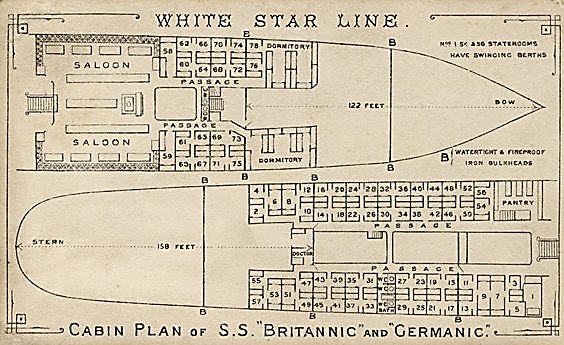
The Germanic was built by Harland and Wolff under keel number 85, was launched on 15 July 1874 and completed on 24 April 1875. She was 455 feet long with a beam of 45.2 feet and had a gross tonnage of 5,008. She had capacity for 1,720 passengers: 220 First Class and 1500 Third Class.
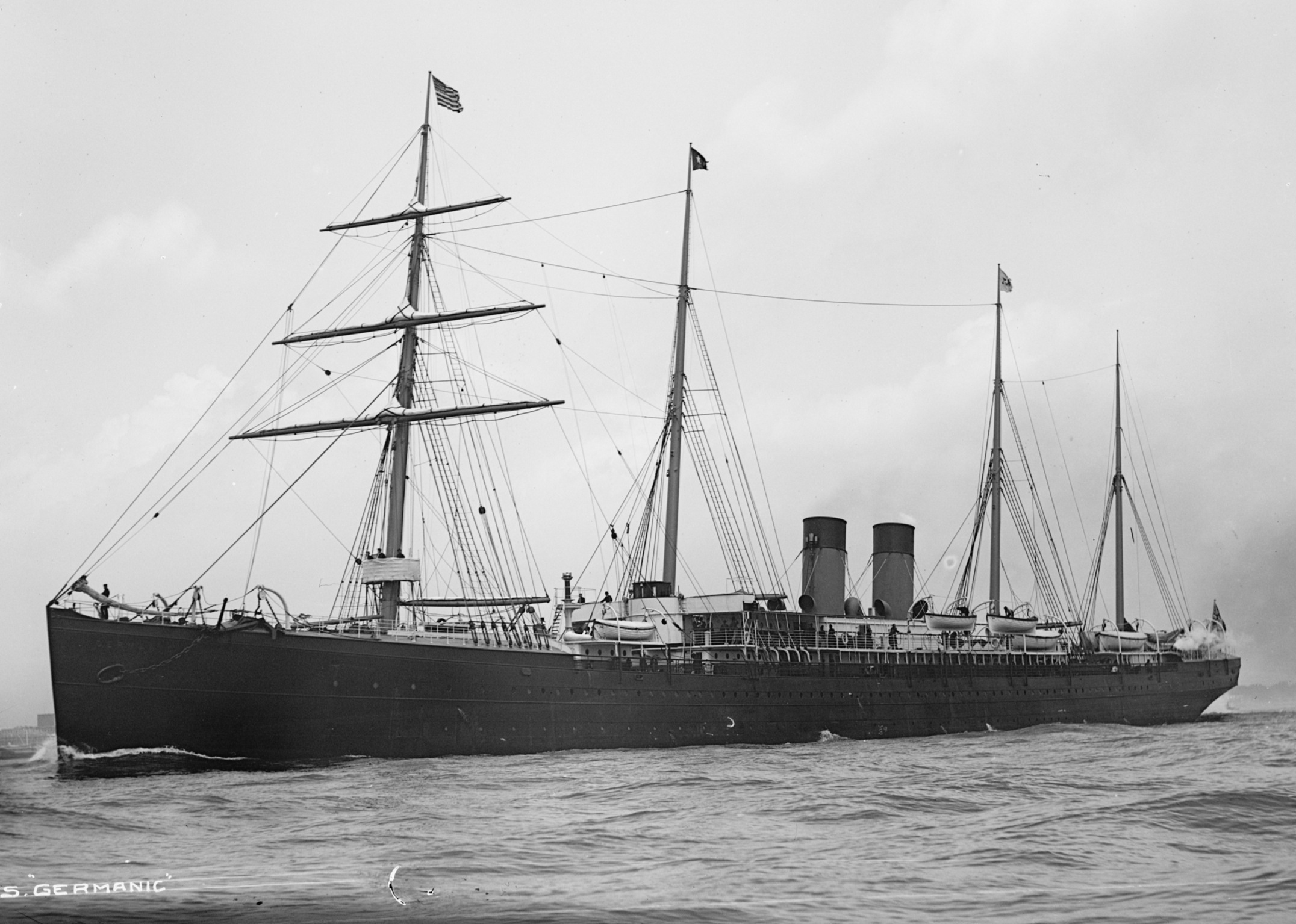
She departed on her maiden voyage on 20 May 1875 from Liverpool to New York, arriving on 30 May. She replaced the Oceanic.
She was the fastest afloat and completed an eastbound crossing across the North Atlantic on 13 February 1876 in just seven days, fifteen hours, and 17 minutes with an average speed of 15.79 knots. She also set the record for the westbound crossing the year later. She won the Blue Riband several times during her career.
The Germanic had a major refit in 1895. A larger triple-expansion steam engine was installed and the square rigging was removed from the masts. On 13 February 1899, while taking on coal at the WSL’s New York City pier, she started to list to port because a heavy blizzard had covered her decks with so much snow that the ship became top heavy. Water poured in to doorways which had been opened for coaling. The Germanic sank and settled on the shallow harbour bottom.
She was raised and returned to Belfast for repairs that took four months to complete. The Germanic left the service of the WSL on 3 September 1903. Thereafter, she was sold several times before being scrapped in 1950.
